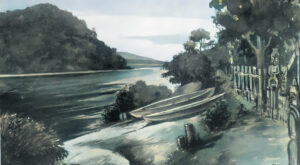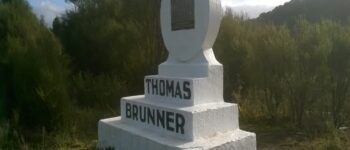1848: Brunner’s Fleet
January 26, 2024
By AHNZ
 Today in New Zealand history, 26 January, 1848, Thomas Brunner set out to explore the Grey River all the way from Mawhera (Greymouth) to Lake Brunner. This was only a sub-expedition for the 27yo man as part of a 550-day expedition. This was Brunner’s second such expedition to Mawhera having been the first white man, along with Charles Heaphy, ever to visit back in 1846.
Today in New Zealand history, 26 January, 1848, Thomas Brunner set out to explore the Grey River all the way from Mawhera (Greymouth) to Lake Brunner. This was only a sub-expedition for the 27yo man as part of a 550-day expedition. This was Brunner’s second such expedition to Mawhera having been the first white man, along with Charles Heaphy, ever to visit back in 1846.
Mind you, the hospitable Ngati Waewae Maoris of Mawhera already loved tobacco and were already Christians. They were in communications with their parent tribe of Ngai Tahu over the Alps in Canterbury so could have brought this knowledge home with them easily. Also, it may be that sealers or even whalers came to Mawhera before Brunner that we do not know about.
After all, Ngati Waewae had only just invaded in about 1795 and the area was still being contested in the late 1830s. Those they deposed, the Ngati Wairangi, might have had stories to tell. However, their genocide silences that tale from being told. George Bass, for example, was one of those visiting the South Island as early as 1803. There are signs of early whaler activity on some southern West Coast islands. Just the same, Brunner and Heaphy are the first white men known to history to have come to the Grey River’s mouth.
Just 12 years later the Mawhera Maoris were in the right place at the right time to be able to sell off this territory when James Mackay visited with bags full of gold coins. Ref. 1860: The West Coast Purchase, AHNZ
“January 26th. This morning freighted our canoe with our provisions, clothes, and fishing apparatus. I considered myself as on board the admiral’s canoe, which was the largest and first to start, having in company three others. The names of the canoes that ascended the river with me were as follows: Te Wairakou, with myself and nine natives; Te Maikai, with my four natives and Aperahama; Te Paiekau, with two natives, carrying nets, etc. for fishing; Te Muttamutta, with four natives–so I think I was well equipped, considering I had nothing to give the natives for all their trouble, except good wishes. There was much crying amongst them when I left, and apparently some good feeling towards me. They told me to return amongst them, and share what they had; and although tobacco is so much valued amongst them, they offered me two sticks–the half of all their stock.” – The Great Journey, Thomas Brunner (ee1952,) Early New Zealand Books Collection, Auckland University
“On 28 January the men of the party went up the Arnold River and came to what is now called Lake Brunner. He mentions that the kiwis were nearly extinct owing to the ravages of the wild dogs. He abandoned the attempt to cross the island owing to the opposition of the natives, who refused to accompany him. Leaving the main stream, he mentions that the Grey is certainly a fine stream; worthy of the Governor after whom he named it. Also Brunner wrote that the district, if it could be connected with a harbour, would make a fine field for colonization. He said he was so pleased with the Grey River that he would not object to visiting again. Brunner mentions that he carried the heaviest load to keep good humour amongst his Maori companions and this enabled him to laugh at them when they complained of feeling tired.” – Tony Kokshoorn (2011)
 Brunner was fresh from his expedition South and back to Mawhera for Christmas where he could rest and recover himself. Ready to move on at last, the 26th of January was a fine clear day on which Brunner and his 2 Nelson Maori companions, with their wives, were paddled up the Grey. They arrived to spend their first night camping on Rocky Island which the natives called Mautapu. This historic spot is marked by a monument (see image above) credited to the Brunner Old Boy’s Association in 1948.
Brunner was fresh from his expedition South and back to Mawhera for Christmas where he could rest and recover himself. Ready to move on at last, the 26th of January was a fine clear day on which Brunner and his 2 Nelson Maori companions, with their wives, were paddled up the Grey. They arrived to spend their first night camping on Rocky Island which the natives called Mautapu. This historic spot is marked by a monument (see image above) credited to the Brunner Old Boy’s Association in 1948.
The monument says the date was 25th January however Brunner’s book says 26th. I’ve decided to side with Brunner as he was the primary source.
Rocky Island was and “old fishing-station” to Brunner who may not have known that to the previous tribe, Ngati Wairangi, it was a sacred burial place. This had been long-since desecrated and converted to new use just as had the burial caves at Mawhera.
On the evening of the 29th Brunner’s party camped at another island, this time in Lake Brunner. Probably Refuge Island, it was once a prison island for captive Maoris who’d had their legs broken so they couldn’t escape. This is not recorded in his book so perhaps Brunner was not told of the cruel history that came this way before him. On the way here there had been fishing and exploring. In particular, Brunner had identified the rich coal seams of future Brunnerton. In just 6 more years it would be mined and go on to be one of New Zealand’s great supplies and the basis of one of the Coast’s big 3 political territories: Brunner Borough. Ref. 1864: Coal on the Coast, AHNZ
All this exploring probably shortened Brunner’s life and it certainly knocked his health around quite a bit. However, he was recognised and employed in a successful career back in Nelson. Especially, his discoveries were paid back by being named after the man who put them on the map.
 The Weekly Graphic and New Zealand Mail of 1910, as repeated by Auckland Libraries Heritage Collections, says Thomas Brunner died at Lake Brunner!
The Weekly Graphic and New Zealand Mail of 1910, as repeated by Auckland Libraries Heritage Collections, says Thomas Brunner died at Lake Brunner!
Although he was injured and starved and abandoned and written off as dead back in Nelson Brunner did not die. Reminds me of some of the dialogue from Never Say Never Again (1983)…
James Bond: With due respect, I played the war games for two weeks and only got killed once.
M: Twice. You’ve forgotten the land mine on the Black Sea beach.
James Bond: Correction, sir. I lost both legs. I did not die.
M: [Unimpressed] You were *immobilized.*
Brunner died back in Nelson in 1874 after some paralysing strokes. He had also been paralised in about 3 months after the Grey River expedition and would have died except for one of his Maori companions, Kehu, who stuck by Brunner when the others departed. Kehu said he did it because he feared the reception he would get back in Nelson if he didn’t bring Brunner back safely! That might have been true or might have been his sense of humor. At any rate, Brunner appears to have paid physically for his Great Journey. Though he married there were no children. Brunner died after an early retirement at the age of 52.
So who did drown at Brunner? The Weekly Graphic is probably thinking of another group. Probably that of Charlton Howitt and two of his survey hands while surveying for the Canterbury Province during August 1863. But who knows? Lots of people have died at that lake over the years. Happily Brunner was not one of them but it would be good to know more about that historic tree.
—
Image ref. AHNZ Archives (2020)
Image ref. Mawhera Pa, Pioneer Library (Greymouth,) Lord (1939) Old Westland, Wiki, enhanced by AHNZ (2024)
 Like Comment Share
Like Comment Share





